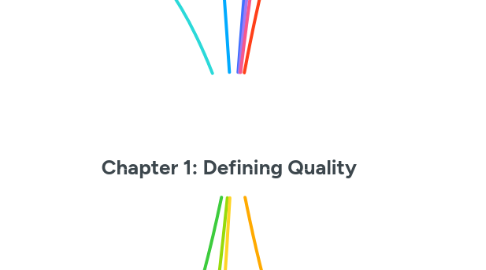
1. Quality in the Genric vs Islamic Perspective
1.1. Similarities
1.1.1. Being positive on customer feedback
1.1.2. Encourages teamworking
1.1.3. Foster positive work attitude
1.1.4. Set systematic/organized procedures and standards.
1.2. Differences
1.2.1. Generic
1.2.1.1. Focuses on material and physical such as facilities, appearence of the output
1.2.1.2. Organization and society being treated as separate entity and not even close.
1.2.1.3. Not emphasizes on internal affairs. For example ISO 9000 is silent on ethical process such as attitude.
1.2.1.4. References Model based on gurus and scholars
1.2.2. Islamic
1.2.2.1. Focus on quality of Insan such as slavery and caliph value harmoniously integrated which is concept of mujahadah and concept of muhasabah
1.2.2.2. Organization and society being treated the same as servant of Allah.
1.2.2.3. Emphasizes on internal affairs such as intention, soul, morality, attitude
1.2.2.4. Reference Model based on Prophet Muhammad (PBUH)
2. Islamic Perspectives of Quality
2.1. A Muslim is enjoined to always strive towards excellenc.
2.2. A Muslim is enjoined to frequently evaluate his good and bad deeds.
2.3. A Muslim is encouraged to undertake all tasks skillfully and diligently.
2.4. Islam demands its adherents to do more than what is minimally required.
2.5. Every actions should begin with a clear intention.
2.6. Islam demands that all Believers should take His Messanger Muhammad (PBUH) as Role Model.
2.7. Islamic Quality Management Standard: The standard is based on the Islamic-Based Quality Organisational Management System 313 (IQOMS 313)
2.8. Halal Food Assurance System (HAFAS)
2.8.1. A set of standards of halal food production for organisations.
2.8.2. Focuses on the system of an organisation to ensure that the organisation produces halal food.
3. Definition of Total Quality
3.1. An approach to doing business that attempts to maximize the competitiveness of an organization through the continual improvement of the quality of its product, services, people, processes and environments. (Goetsch & Davis, 2010)
3.2. Continually improving effort by everyone in an organization to understand, meet and exceed the expectations of customers. (P&G; quoted by Evans and Lindsay, 2008)
3.3. The total in TQ indicates a concern for QUALITY IN THE BROADEST SENSE - what has come to be known as the "Big Q".
3.3.1. "Big Q" refers to quality of products, services, people, processes and environments.
4. Differencee between QA and QC
4.1. QA - To improve and stabilize the production in order to avoid the issue that lead to defect.
4.2. QC - Emphasizes testing of products to uncover defects and reports to management in order to make decision whether to allow or deny the release.
5. Key Elements of Total Quality
5.1. Strategically based
5.1.1. Have comprehensive strategic plan
5.2. Customer focus
5.3. Obsession with quality
5.3.1. Become obsess with excedding customer expectations
5.4. Scientific approach
5.4.1. Using hard data to monitor performance
5.5. Long-term commitment
5.5.1. Using hard data to monitor
5.6. Teamwork
5.7. Continual Process Improvement
5.7.1. a fundamental goal in total quality setting
5.8. Education and training
5.8.1. The best way for continuous improvement of the people
5.9. Freedom through control
5.9.1. Empowering employee to solve problems within their scope of control
5.10. Unity of purpose
5.10.1. All employee work toward the common goal
5.11. Employment involvement and empowerment
6. Definition of Quality
6.1. "Performance to the standard expected by the customer" (Fred Smith, CEO of Federal Express)
6.2. "Doing the right thing right the first time, always striving for improvement and always satisfying the customer." (US Dept. of Defense [DOD]).
7. Similarities
7.1. Quality involves meeting or exceeding customer expectations
7.2. Quality is an everchanging state.
8. Definition of Quality Assurance
8.1. Any planned and systematic activity that provide consumers with products to meet consumer requirements.
8.1.1. "Fit for purpose" -Product must be suitable for its intended purpose.
8.1.2. "Rights first time" -Mistake should be eliminated.
9. Definition of Quality Control
9.1. Has three process to ensure the quality of product is maintained
9.1.1. Evaluate actual quality performance.
9.1.2. Compare actual performance with performance goals.
9.1.3. Take the immediate step to resolve differences between planned performance and actual performance.
10. TQ views vs Traditional Views of Quality
10.1. Productivity vs. Quality
10.1.1. Traditional Views
10.1.1.1. Productivity and quality are always in conflict.
10.1.2. TQ Views
10.1.2.1. Productivity gains are made only as a result of quality improvements.
10.2. How quality is defined
10.2.1. Traditional Views
10.2.1.1. Solely as meeting customer specifications and mostly defined by the management.
10.2.2. TQ Views
10.2.2.1. Satisfying customers by meeting and exceeding their expectations and defined by customers.
10.3. How quality is measured
10.3.1. Traditional Views
10.3.1.1. Measured just by establishing an acceptable level of noncomformance and measuring against that benchmark.
10.3.2. TQ Views
10.3.2.1. Measured using scientific approach by establishing high-performance benchmarks, monitoring the performance and continually improving performance.
10.4. How quality is achieved
10.4.1. Traditional Views
10.4.1.1. Inspected into the product
10.4.2. TQ Views
10.4.2.1. Determined by the product and process design through inspection with appropriate and effective control techniques.
10.5. Attitude toward defects
10.5.1. Traditional Views
10.5.1.1. Defect is an expected which is defects are still acceptable and are expected.
10.5.2. TQ Views
10.5.2.1. Defects are to be prevented which is defects are unacceptable and should be prevented.
10.6. Quality as a function
10.6.1. Traditional Views
10.6.1.1. a separate function that quality department responsible to in-charge of quality
10.6.2. TQ Views
10.6.2.1. fully integrated throughout the organization using integrated system approach
10.7. Responsibility for quality
10.7.1. Traditional Views
10.7.1.1. Employees are responsible and blame for poor quality.
10.7.2. TQ Views
10.7.2.1. Managers besides other are also held responsible for any fault or anything about quality.
10.8. Supplier Relationships
10.8.1. Traditional views
10.8.1.1. Supplier relationships are short term and cost oriented
10.8.2. TQ Views
10.8.2.1. Supplier relationships are long term and quality oriented.
